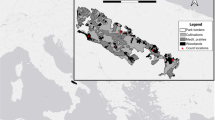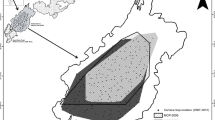Abstract
Characteristics of the reproductive behaviour of wolves (Canis lupus) were studied by radio-tracking and snow-tracking of four packs in Białowieża Primeval Forest (BPF), Poland, in 1995–1999. Signs of mating occurred between 12 January and 22 March. Parturition occurred between 19 April and 12 May, and the denning period lasted for 49–64 days. During that time, wolves used 1–3 den sites, spending on average 27 days at each site. The dens were never reused in consecutive years, but year after year the breeding sites were located in the same parts of the pack’s territory. Ten days before parturition pregnant females reduced their normal mobility by half (from 23 to 13.5 km day−1, on average). During the ten days post-partum, they spent 85% of their time with pups and travelled 3.9 km day−1, only. On days 11–30 after parturition, females spent 74% of their time tending pups and increased their daily movement distance to a mean of 13.3 km. The females resumed full mobility 50–70 days after parturition, which coincides with termination of the weaning process. Anecdotal observations indicated that pups were tended by other pack members while the mother was absent. Compared with the years 1947–1950, in 1995–1999 the breeding season of wolves in BPF occurred two weeks earlier. A possible reason was the 1 to 1.5-degree increase in the mean annual temperature during the last 50 years.





Similar content being viewed by others
References
Annenkov BP (1988) The wolf in the Alakolsk valley. Akad Nauk Kazakhskoi SSR Tr Inst Zool 44:69–73 [in Russian]
Ballard WB, Whitman JS, Gardner CL (1987) Ecology of an exploited wolf population in south-central Alaska. Wildl Monogr 98:1–54
Ballard WB, Dau JR (1983) Characteristic of gray wolf, Canis lupus, den and rendezvous sites in south central Alaska. Can Field Nat 97:299–302
Ballard WB, Ayres LA, Gardner CL, Foster JW (1991) Den site activity patterns of gray wolves, Canis lupus, in south central Alaska. Can Field Nat 105:497–504
Boertje RD, Stephenson RO (1992) Effects of ungulate availability on wolf reproductive potential in Alaska. Can J Zool 70:2441–2443
Boyd DK, Ream RR, Pletscher DH, Fairchild MW (1993) Variation in denning and parturition dates of a wild gray wolf, Canis lupus, in the Rocky Mountains. Can Field Nat 107:359–360
Ciucci P, Mech LD (1992) Selection of wolf dens in relation to winter territories in northeastern Minnesota. J Mammal 73:899–905
Fedosenko AK, Zhiryakov VA, Grachev YA (1978) Some data on the ecology and behavior of wolves in the Northern Tien-Shan and Dzungara Alatau. Byull Mosk Obshch Ispyt Prir Otd Biol 83(3):5–18 [in Russian with English summary]
Filimonov AN (1980) Behavior of the Kazakhstan wolves in various situations. In: Bibikov DI (ed) Behaviour of wolves. Institut Evolucionnoi Morfologii i Ekologii Zhivotnykh, Akademiya Nauk SSSR, Moskva, pp 60–76 [in Russian]
Fuller TK (1989) Denning behavior of wolves in north-central Minnesota. Am Midl Nat 121:184–188
Gavrin VF, Donaurov SS (1954) The wolf in Białowieża Primeval Forest. Zool Zh 33:904–924 [in Russian]
Gray DR (1993) The use of muskox kill sites as temporary rendezvous sites by arctic wolves with pups in early winter. Arctic 46:324–330
Gursky IG (1978) The wolf in the northwestern Black Sea region (habitats, structure of populations, reproduction). Byull Mosk Obshch Ispyt Prir Otd Biol 83(3):29–38 [in Russian with English summary]
Harrington FH, Mech LD (1982) Patterns of homesite attendance in two Minnesota wolf packs. In: Harrington FH, Paquet PC (eds) Wolves of the world. Noyes Publications, NJ, pp 81–105
Jędrzejewska B, Jędrzejewski W (1998) Predation in vertebrate communities. The Białowieża Primeval Forest as a case study. Springer, Berlin Heidelberg New York
Jędrzejewska B, Jędrzejewski W, Bunevich AN, Miłkowski L, Okarma H (1996) Population dynamics of wolves Canis lupus in Białowieża Primeval Forest (Poland and Belarus) in relation to hunting by humans, 1847–1993. Mammal Rev 26:103–126
Jędrzejewski W, Schmidt K, Theuerkauf J, Jędrzejewska B, Okarma H (2001) Daily movements and territory use by radio-collared wolves, (Canis lupus) in Białowieża Primeval Forest in Poland. Can J Zool 79:1993–2004
Jędrzejewski W, Schmidt K, Theuerkauf J, Jędrzejewska B, Selva N, Zub K, Szymura L (2002) Kill rates and predation by wolves on ungulate populations in Białowieża Primeval Forest (Poland). Ecology 83:1341–1356
Jędrzejewski W, Branicki W, Veit C, Medugorac I, Pilot M, Bunevich AN, Jędrzejewska B, Schmidt K, Theuerkauf J, Okarma H, Gula R, Szymura L, Förster M (2005) Genetic diversity and relatedness within packs in an intensely hunted population of wolves Canis lupus. Acta Theriol 50:3–22
Jędrzejewski W, Schmidt K, Theuerkauf J, Jędrzejewska B, Kowalczyk R (2007) Territory size of wolves Canis lupus: linking local (Bialowieza Primeval Forest, Poland) and Holarctic-scale patterns. Ecography (in press)
Kreeger TJ (2003) The internal wolf: physiology, pathology, and pharmacology. In: Mech LD, Boitani L (eds) Wolves: behavior, ecology and conservation. The University of Chicago Press, Chicago, pp 192–217
Makridin VP (1959) Materials on the biology of wolf in tundra of the Nenets national region. Zool Zh 38:1719–1728 [in Russian with English summary]
Mech LD (1970) The wolf: the ecology and behavior of an endangered species. Natural History Press, Garden City, New York
Mech LD (1988) The Arctic Wolf: living with the pack. Voyageur Press, Stillwater, MN
Mech (LD) (1999) Alpha status, dominance, and division of labor in wolf packs. Can J Zool 77:1196–1203
Mech LD (2002) Breeding season of wolves, Canis lupus, in relation to latitude. Can Field Nat 116:139–140
Mech LD, Packard JM (1990) Possible use of wolf, (Canis lupus), den over several centuries. Can Field Nat 104:484–485
Mech LD, Wolf PC, Packard JM (1999) Regurgitative food transfer among wild wolves. Can J Zool 77:1192–1195
Murrie A (1944) The wolves of Mount McKinley. Fauna of the National Parks of the United States. Fauna Ser. 5, Washington, DC
Nowak S, Jędrzejewski W, Schmidt K, Theuerkauf J, Mysłajek RW, Jędrzejewska B (2007) Howling activity of free-ranging wolves (Canis lupus) in the Białowieża Primeval Forest and the Western Beskidy Mountains (Poland). J Ethol (in press). DOI 10.1007/s10164-006-0015-y
Okarma H, Jędrzejewski W (1997) Livetrapping wolves with nets. Wildl Soc Bull 25:78–82
Okarma H, Jędrzejewski W, Schmidt K, Śnieżko S, Bunevich AN, Jędrzejewska B (1998) Home ranges of wolves in Białowieża Primeval Forest, Poland, compared with other Eurasian populations. J Mammal 79:842–852
Packard JM (2003) Wolf behavior: reproductive, social, and intelligent. In: Mech LD, Boitani L (eds) Wolves: behavior, ecology and conservation. The University of Chicago Press, Chicago, pp 35–65
Packard JM, Mech LD, Seal US (1983) Social influences on reproduction in wolves. In: Carbyn LN (ed) Wolves in Canada and Alaska: their status, biology, and management. Report Series, no 45. Canadian Wildlife Service, Edmonton, AB, pp 78–85
Packard JM, Mech LD, Ream RR (1992) Weaning in an arctic wolf pack: behavioural mechanisms. Can J Zool 70:1269–1275
Pulliainen E (1965) Studies on the wolf (Canis lupus L.) in Finland. Ann Zool Fenn 2:215–259
Ryabov LS (1988) Characteristics of wolves (Canis lupus L.) reproduction in the Central Black Earth Region. Ekologiya 6:42–48 [in Russian]
Seal US, Plotka ED, Packard JM, Mech LD (1979) Endocrine correlates of reproduction in the wolf I. Serum progesterone, estradiol and LH during the estrous cycle. Biol Reprod 21:1057–1066
Theuerkauf J, Jędrzejewski W (2002) Accuracy of radiotelemetry to estimate wolf activity and locations. J Wildl Manage 66:859–864
Theuerkauf J, Jędrzejewski W, Schmidt K, Okarma H, Ruczyński I, Śnieżko S, Gula R (2003a) Daily patterns and duration of wolf activity in the Białowieża Forest, Poland. J Mammal 84:243–253
Theuerkauf J, Jędrzejewski W, Schmidt K, Gula R (2003b) Spatiotemporal segregation of wolves from humans in the Białowieża Forest (Poland). J Wildl Manage 67:706–716
Theuerkauf J, Rouys S, Jędrzejewski W (2003c). Selection of den, rendezvous, and resting sites by wolves in the Białowieża Forest, Poland. Can J Zool 81:163–167
Thiel RP, Haller WH, Schultz RN (1997) Early den digging by wolves, Canis lupus, in Wisconsin. Can Field Nat 111:481–482
Thiel RP, Merril S, Mech LD (1998) Tolerance by denning wolves, Canis lupus, to human disturbance. Can Field Nat 112:340–342
Thurston LM (2002) Homesite attendance as a measure of alloparental and parental care by gray wolves (Canis lupus) in Northern Yellowstone National Park. MSc thesis, Texas A and M University, USA
Vyrypaev VA, Vorobev GG (1983) The wolf in Kyrgyzstan—ecological and geographic description. Izdatelstvo Ilim, Frunze [in Russian]
Zub K, Theuerkauf J, Jędrzejewski W, Jędrzejewska B, Schmidt K, Kowalczyk R (2003) Wolf pack territory marking in the Białowieża Primeval Forest (Poland). Behaviour 140:635–648
Acknowledgments
This study was financed by the budget of the Mammal Research Institute PAS, the Polish State Committee for Scientific Research (grants 6P20401905 and 6P04F02612), the European Natural Heritage Fund (Euronatur, Germany), the German Academic Exchange Service (to JT), and the German Donor’s Association for the Promotion of Sciences and Humanities (to JT). We thank S. Śnieżko, R. Kozak, I. Ruczyński, M. Chudziński, P. Wasiak, S. Rouys, and R. Gula, and numerous students and volunteers, who helped during the field work. Permission to capture and radio-collar wolves were issued by Ministry of Forestry and Nature Protection and the Director of Białowieża National Park.
Author information
Authors and Affiliations
Corresponding author
About this article
Cite this article
Schmidt, K., Jędrzejewski, W., Theuerkauf, J. et al. Reproductive behaviour of wild-living wolves in Białowieża Primeval Forest (Poland). J Ethol 26, 69–78 (2008). https://doi.org/10.1007/s10164-006-0031-y
Received:
Accepted:
Published:
Issue Date:
DOI: https://doi.org/10.1007/s10164-006-0031-y




